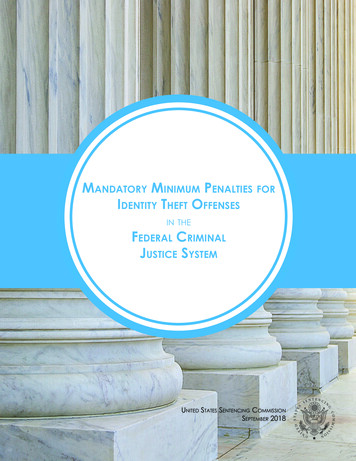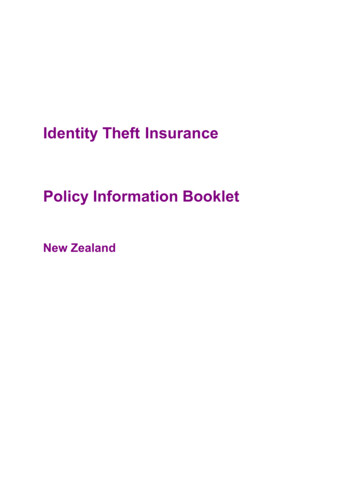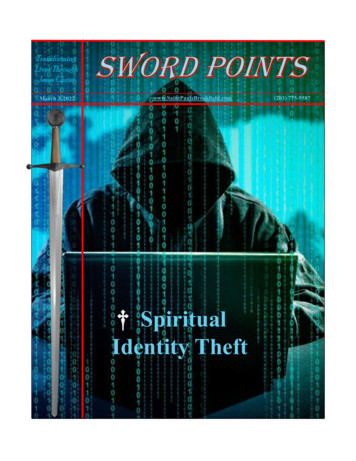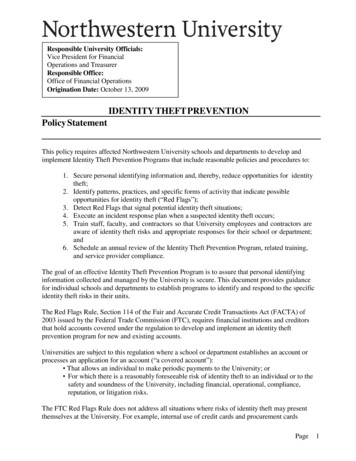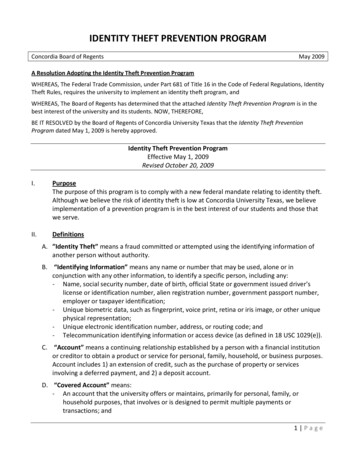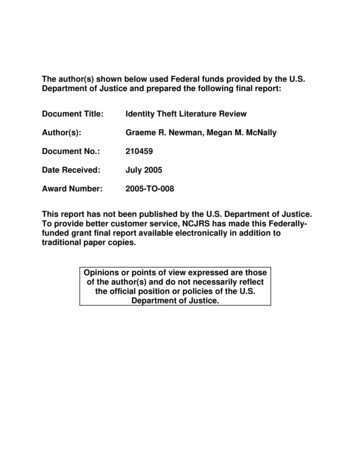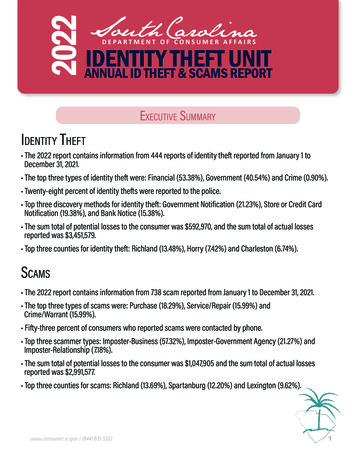
Transcription
2022IDENTITYTHEFTUNITANNUAL ID THEFT & SCAMS REPORTExecutive SummaryIdentity Theft The 2022 report contains information from 444 reports of identity theft reported from January 1 toDecember 31, 2021. The top three types of identity theft were: Financial (53.38%), Government (40.54%) and Crime (0.90%). Twenty-eight percent of identity thefts were reported to the police. Top three discovery methods for identity theft: Government Notification (21.23%), Store or Credit CardNotification (19.38%), and Bank Notice (15.38%). The sum total of potential losses to the consumer was 592,970, and the sum total of actual lossesreported was 3,451,579. Top three counties for identity theft: Richland (13.48%), Horry (7.42%) and Charleston (6.74%).Scams The 2022 report contains information from 738 scam reported from January 1 to December 31, 2021. The top three types of scams were: Purchase (18.29%), Service/Repair (15.99%) andCrime/Warrant (15.99%). Fifty-three percent of consumers who reported scams were contacted by phone. Top three scammer types: Imposter-Business (57.32%), Imposter-Government Agency (21.27%) andImposter-Relationship (7.18%). The sum total of potential losses to the consumer was 1,047,905 and the sum total of actual lossesreported was 2,991,577. Top three counties for scams: Richland (13.69%), Spartanburg (12.20%) and Lexington (9.62%).www.consumer.sc.gov (844) 835-53221
South Carolina Department of Consumer Affairs ID Theft & Scams Report 2022Identity Theft in South CarolinaIdentity thieves can use your information anyway you do. Once identity thieves have your personal information,they can drain your bank account, run up charges on your credit cards, open new utility accounts, or get medicaltreatment on your health insurance. An identity thief can file a tax return in your name and get your refund.The charts below reflect identity theft reported to SCDCA in 2021.Top Reported ID Theft444 REPORTSTOP THREE al ID theft includes the misuse of existing ATM/debit/credit cardsor checks/checking accounts, or opening new credit cards, loans, or utilityaccounts using someone else’s identifying information.GovernmentGovernment ID theft includes tax fraud, being denied disability, public assistance,social security, unemployment benefits and license related fraud.CrimeWarrants or citations have been issued in your name for crimes/offenses thatyou did not commit. Example: A warrant is out for your arrest because yoursocial security card was found at the scene of a crime.POTENTIAL LOSSES 592,970This is the total amount of money reported stolenthrough ID theft that the consumer was able to getback or credited to their account(s).consumer.sc.gov (844) 835-5322ACTUAL LOSSES 3,451,579This is the total amount of money reported lost toSCDCA by consumers who were ID theft victims.2
South Carolina Department of Consumer Affairs ID Theft & Scams Report 2022ID Theft by Age RangeThis graph shows the age ranges of consumers who reported being affected by identity theft. Undisclosed means that theconsumer did not give their age when filing a report.ID Theft Consumer Discovery MethodThis graph shows the way consumers found out that they were victims of identity theft. Top three categorizeddiscovery methods for identity theft: Government Notification (21.23%), Store or Credit Card Notification (19.38%), andBank Notice (15.38%).consumer.sc.gov (844) 835-53223
South Carolina Department of Consumer Affairs ID Theft & Scams Report 2022ID Theft Count by NumberThis map shows the number of identity theftreported in each county.ID Theft Reports Per Capita (Per 1,000)This map takes into account the county’s populationand is calculated per 1,000 people. Its purpose is toshow the impact of identity theft on a communitywhen population is considered.consumer.sc.gov (844) 835-53224
South Carolina Department of Consumer Affairs ID Theft & Scams Report 2022Scams in South CarolinaCrooks use clever schemes to defraud millions of people every year. They often combine sophisticatedtechnology with age-old tricks to get people to send money or give out personal information. They add newtwists to old schemes and pressure people to make important decisions on the spot. One thing that neverchanges: they follow headlines—and the money.The charts below reflect scams reported to SCDCA in 2021.Top Reported Scams738 REPORTSTOP THREE aseConsumer directed to or approached by imposter business to trick consumerinto paying for fake consumer goods. Most online purchase scams occur when apayment is made online to purchase something, and nothing is delivered.Service/RepairConsumer directed to or approached by imposter business to trick consumerinto paying for a fake service or repair. Example: Fake credit repair companies;internet services.CrimeWarrants or citations have been issued in your name for crimes/offenses thatyou did not commit. Example: A warrant is out for your arrest because yoursocial security card was found at the scene of a crime.POTENTIAL LOSSESACTUAL LOSSESThis is the total amount of money reported toSCDCA by consumers who did NOT fall for a scam.This is the total amount of money SCDCA byconsumers who DID fall for a scam. 1,047,905consumer.sc.gov (844) 835-5322 2,991,5775
South Carolina Department of Consumer Affairs ID Theft & Scams Report 2022Scams by Age RangeThis graph shows the age ranges of consumers who reported being affected by a scam. Undisclosed means that theconsumer did not give their age when filing a report.Scammer Contact MethodThis graph shows the way scammers contacted consumers who filed reports with SCDCA. Fifty-four percent ofconsumers who reported scams were contacted by phone.consumer.sc.gov (844) 835-53226
South Carolina Department of Consumer Affairs ID Theft & Scams Report 2022Scam Count by NumberThis map shows the number of scams reportedin each county.Scam Reports Per Capita (Per 1,000)This map takes into account the county’spopulation and is calculated per 1,000people. Its purpose is to show the impact of scamson a community when population is considered.consumer.sc.gov (844) 835-53227
South Carolina Department of Consumer Affairs ID Theft & Scams Report 2021IDTHEFTCLUESWHAT TO WATCH OUT FOR:IDENTITY THIEVES CAN USE YOUR INFORMATION ANYWAY YOU DOOnce identity thieves have your personal information, they can drain your bank account, run up charges on your creditcards, open new utility accounts, or get medical treatment on your health insurance. An identity thief can file a taxreturn in your name and get your refund. In some extreme cases, a thief might even give your name to the policeduring an arrest.EVERYOther Benefits Medical providers bill you for services you didn’t use. Your health plan rejects your legitimate medical claim because the records showyou’ve reached your benefits limit. A health plan won’t cover you because your medical records show a conditionyou don’t have. The IRS notifies you that more than one tax return was filed in your name, or that youhave income from an employer you don’t work for. You find errors on your social security statement.F ID THEFT IS DOISEContact SCDCA’sIdentity Theft Unitfor guided identitytheft help.THINKING OUTSIDE THE BOXConsider these other tools for protecting your accounts. Many banks offer accountalerts that can fit your needs: Get a text if your balance falls below a certain number. Get an email or phone call if a charge greater than X (i.e. 100) hits your account.These alerts can make watching existing accounts less of a hassle.WATCH OUT FOR SCAMSScam artists follow the headlines. Don’t give your personal information to someone you don’t know. Be wary ofcalls, emails, texts and pop-ups you did not solicit. Scammers can use information taken from a breach to maketheir request seem legit. When in doubt, cut-off contact. To report a scam or to get help if you gave your info to ascammer, contact SCDCA’s Identity Theft Unit at (800) 922-1594 or by visiting www.consumer.sc.gov and clicking“Identity Theft Unit.”South Carolina Department of Consumer Affairs293 Greystone Blvd. STE 400 PO Box 5757 Columbia, SC 29210(800) 922-1594 www.consumer.sc.govNT!EREFFFinancial Accounts You see withdrawals from your bank account that you can’t explain. You don’t get your bills or other mail. Debt collectors call you about debts that aren’t yours. You find unfamiliar addresses, accounts or charges on your credit reportCASIGNS YOU MIGHT BE A VICTIM OF IDENTIFY THEFT
ANNUAL ID THEFT & SCAMS REPORT ExEcutivE Summary The 2022 report contains information from 444 reports of identity theft reported from January 1 to December 31, 2021. The top three types of identity theft were: Financial (53.38%), Government (40.54%) and Crime (0.90%). Twenty-eight percent of identity thefts were reported to the police.

